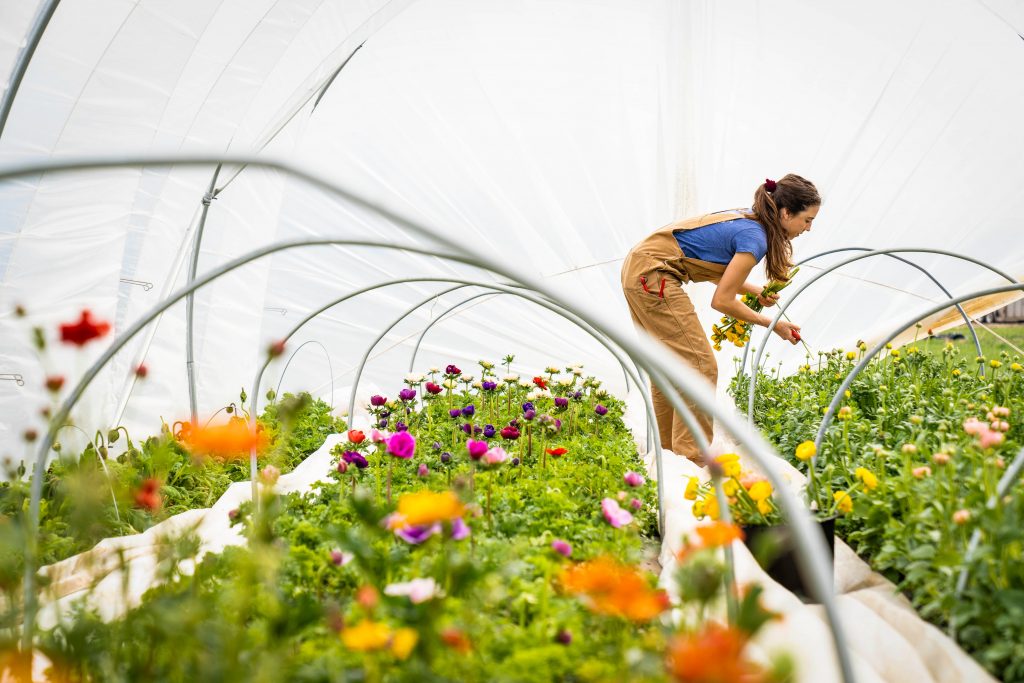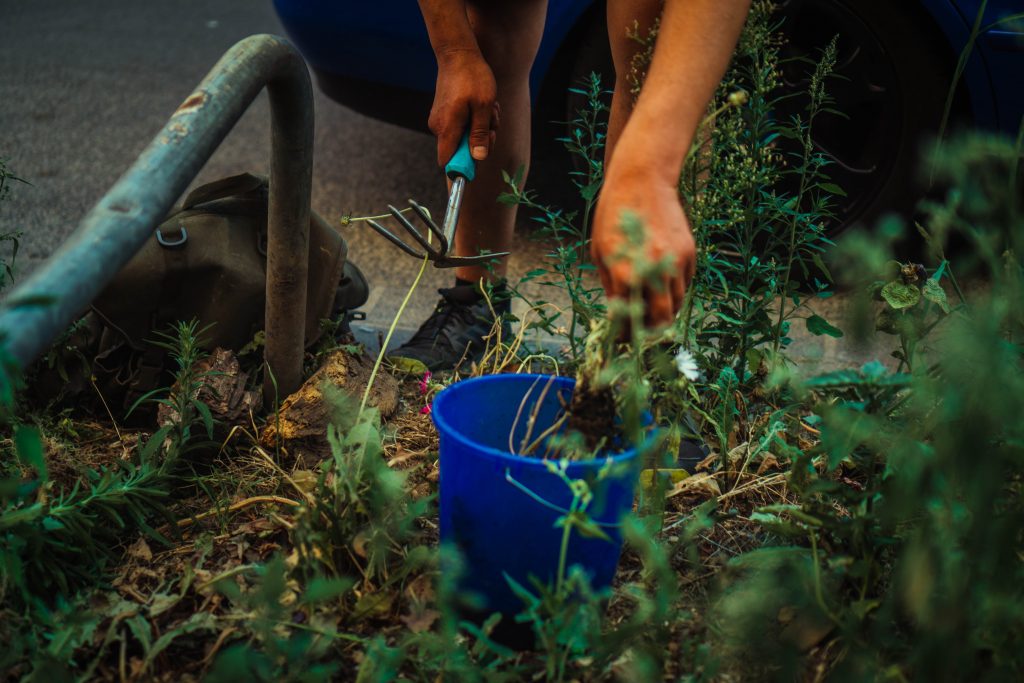As the desire for eating healthy, fresh, organic and home-grown produce grows, naturally so does the desire for gardening. But where to garden when you live in a densely populated city? Urban gardens offer the perfect escape from a busy, crowded environment to a small green, peaceful patch of the neighbourhood. Discover what the current head of the organisation Garteln in Wien has to say about the topic.
We had a conversation with Katharina Roth, head of an organisation called Garteln in Wien, a.k.a. “Gardening in Vienna”. It’s a coordination and support centre set up by the city, and it offers everyone information on where to grow their food and buy fresh produce in Vienna. It also offers guidance in establishing gardens, various workshops and educational courses.
Vienna seems like a go-to spot for enthusiastic gardeners because the city offers a wide spectrum of gardening possibilities, not just community gardens. Even though the organisation is centred in Vienna, this article could be at least of help, if not actually applicable, to anyone, anywhere.
Types of Urban Gardens
The first important thing is to know the difference between bottom-up and top-down gardens – and no, don’t worry, no acrobatics involved. Essentially, the meanings of the terms are: bottom-up gardens are when citizens decide to create an urban garden and are looking for a place to do it; top-down gardens are when municipal departments, or other organisations, start with the initiative.
It works best when they are mixed, and the urban gardens created can be of different sorts:
Community Gardens
Community gardens involve people of the neighbourhood who actively garden together. Most community gardens are meant for long-term use, but temporary memberships are also available. Usually, a membership is required to be paid. However, there are some gardens where everyone is invited to participate for free. Some community gardens emphasise intercultural gardening, while others involve schools and kindergartens (providing them with the opportunity to learn while actively participating in the maintenance of the garden) – either way, collaboration is the key aspect of these type of gardens.
“It’s the vegetables, the flowers, and the community collaboration, which give them the opportunity to flourish. People of all ages and cultures are involved, and if the garden is led correctly, all of them have a voice.”
In Vienna, adds Katharina, most of the gardens are connected with some organisations, which help people to build a strong community. However, this seems to be the case in other countries and on other continents, too – as an example, read here about how this works in Australia.
Community Made Agriculture
Another possibility for urban gardening is community-made agriculture (or CMA). It’s based on solidarity and represents farming together with people who have the same goal. It’s not just about gardening, though, it’s also a political statement of “do not live at the expense of others!”, meaning don’t live at the expense of nature or those who earn too little for their work.
The difference to community gardens is that there are no private gardening beds; it’s rather all together, a mix of crops, and each member is assigned responsibility for a certain vegetable, who “becomes a Minister of carrots, or a Minister of tomatoes,” adds Katharina. And the more work or responsibility someone has, the more they’re allowed to harvest.

Vegetable Plots for Rent
This is perfect for people who are really engaged in farming themselves and who want to eat the vegetables they grow during the summer season (from May to the end of October). How it works is they rent a vegetable plot (or a self-harvesting parcel) from an agricultural business whose owners are mostly farmers. They provide cultivated land and organic seeds, which are planted in rows and divided into plots. And the best part: these plots are certified organic – vegetables are harvested when they’re ready to be eaten, not when it’s time to sell them. Their nutritional wealth is higher than of those bought in the supermarket.
It’s a win-win situation: the tenants grow their own food, and the farmers receive monetary compensation. For 40 m2, tenants pay approx. €152, depending on the location of the farming plots in the city. Whereas if they paid for the produce in the supermarket, they would have spent approx. €900 in that time span.
For farmers, this represents an easy solution to their working hours as a lot of work is involved in cultivating vegetables – Katharina explains that if tenants do it skilfully, more than 250 kg of vegetables can be harvested in one season just on one 40 m2 plot. And if they don’t invest enough time into maintaining their plot, there will only be weeds coming out of their soil. So, it’s a lot of work going into growing vegetables, and tenants are the ones who experience this the most:
“And the next time they buy a vegetable, the tenants are very thankful to the people who do it on purpose and as a profession.”
Currently, the demand for plots is so high that some farms are fully booked before the season even begins.
Gardening in Public Housing
Public housing is mostly known for community gardens; however, there are other possibilities too.
At the entrances of the houses, there are usually green patches with grass or other plants. Residents who don’t want to join a community garden can care for the space right on their doorstep. But it’s meant more for growing flowers, instead of growing food.
Residents can also install mobile beds – usually, there is space for 9 to 15 beds in one public housing unit. Basically, they are raised beds in the housing courtyard, put there on request, and any resident that wants can participate in taking care of them.
Gardening Around the Corner
This type is for more active residents who don’t care as much for the growing produce but want to enhance the surrounding biodiversity. Individuals tend to the small green spaces around trees in their living area, usually by planting flowers.
The municipal department especially supports this type of gardening as it means less work for the city. Interested residents need only check first with the municipality if a certain project has been done recently on the lot and if it’s safe for them to be there and garden. They contact the municipal office and agree on the conditions and terms. The office then contacts the road administrations for their final approval, and the gardening can begin.
This programme is completely free for the residents.
Volunteer Organic Farms
In short, volunteer organic farms are for those who “want a taste of organic farm life, rather than the responsibility of a farm for the whole season.”
Those interested register as volunteers and go to work on a roof farm for a week or couple of days. Food and housing are provided to them as payment.
Katharina points out: “it’s a very good opportunity if you have no clue what you’re doing with gardening, but you want to try it out and do it with a professional. And what I like best about urban farming in Vienna is that it is everywhere organic because you don’t want people who have no clue about pesticides working with pesticides.”
There are several such farms in Vienna – you can get in touch with them here.
Water, Energy and Security: Needed Elements for a Functioning Garden
According to Katharina, gardens usually don’t require any energy; but it’s a completely different story when it comes to water. Its supply depends on whether the garden is cared for by the city or not. If the garden is in the centre of public housing, no extra costs are made. However, if the garden involves people who are part of the neighbourhood but don’t necessarily live in the public housing units, additional expenses are created as the water is paid for by the community. In this case, gardeners usually pay for the ground (and water usage) through membership. If the garden is on public ground, the membership is around €100 per year per member. If the garden is not on public ground, memberships can be higher.
Security issues are usually not an issue at all for urban gardeners. Katharina says that usually, more produce is grown than a single gardener can eat. So again, it’s all about cooperation and community. However, if the garden is in a public space, there is an annual check-up from the municipal department, which also care for any trees that might be in the gardens. And any changes that are made to the public grounds need to be first approved by the city – most of the things are allowed, with the exception of growing poisonous plants.

How to Join a Garden
If urban gardening is something you would like to do, you just have to ask. First, decide on the type of urban garden that would work best for you, then search for one in your area. Send a request, fill out a ‘join us’ form, or give them an old-fashioned phone call. If there’s still a place, you will most likely have to wait until next year until the start of the next season to join. Then you attend the meetings, potentially pay the membership fee and get involved. But as Katharina points out, most often new members only get a common gardening bed for the first year, and then in the second or third year, they get their own private beds. It depends on how many people want to be involved in the garden.
How to Start an Urban Garden
Now for those more ambitious: how can you start a garden? First, settle on a place where you want the garden to be, and calculate approximately how much it would cost to set it up. Next, find out who the owner is – here is where your path can go two ways:
1. If the land is on private ground:
- Contact a community gardening organisation.
- The organisation contacts the municipal department responsible for it.
- Through the organisation, you get involved with the same municipal department.
- You establish an association and set up a contract.
2. If the land is on public ground:
- You need to have at least five people interested in joining the garden.
- A system of changing members needs to be implemented; because it shouldn’t be just five people owning the public ground, it should be a rotation.
- Gardens need to be opened for the public at least once a year. Typically, urban gardeners organize festivities or parties, inviting other people from the neighbourhood.
- It’s important to involve not just those who love gardening but everyone – anyone can contribute. For example, someone can mow the lawn, someone can build benches, someone else can make sure the garden is locked every day.
All that being said, the most important part is involving people:
“If you instal community garden or mobile beds, you really have to care for who was in the very same space before and absolutely involve them in the process.”
After all, isn’t this the whole point of urban gardens? To become a part of something, to build relationships and establish a sense of a community? No point in excluding others simply because they might not fit in with your idea of what an urban garden should look like.

Urban Gardening in a Nutshell
No matter your intentions for joining an urban garden – either to become a part of the community, produce fresh vegetables and fruits, satisfy your green thumb’s need, or just to get some fresh air and exercise – there’s certainly a perfect option available to you. Check with your local organisations, discover which gardens are accepting new members, or even start your own: possibilities are endless. Simply go for it.


